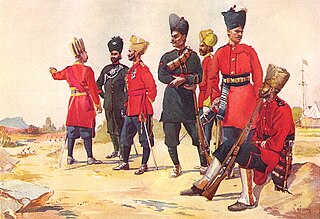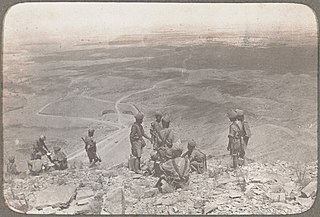Related Research Articles

The Grenadiers is an infantry regiment of the Indian Army, formerly part of the Bombay Army and later the pre-independence British Indian Army, when the regiment was known as the 4th Bombay Grenadiers. It has distinguished itself during the two world wars and also since the Independence of India. The regiment has won many battle honours and gallantry awards, and is considered to be one of India's most decorated regiments with three Param Vir Chakra awardees in three different conflicts.

The 62nd Punjabis was an infantry regiment of the British Indian Army. It was raised in 1759 as the 3rd Battalion of Coast Sepoys, and formed part of the Madras Army. It was designated as the 62nd Punjabis in 1903 and became 1st Battalion 1st Punjab Regiment in 1922. In 1947, it was allocated to the Pakistan Army, where it continues to exist as 1st battalion, Punjab Regiment. It is the senior-most surviving infantry battalion of the British Indian Army.

The 66th Punjabis was an infantry regiment of the British Indian Army. It was raised in 1761 as the 7th Battalion of Coast Sepoys. It was designated as the 66th Punjabis in 1903 and became 2nd Battalion 1st Punjab Regiment in 1922. In 1947, it was allocated to the Pakistan Army, where it continues to exist as 2nd Battalion The Punjab Regiment.

The 76th Punjabis was an infantry regiment of the British Indian Army. It was raised by Captain Thomas Lane at Trichonopoly on 16 December 1776, as the 16th Carnatic Battalion. It was designated as the 76th Punjabis in 1903 and became the 3rd Battalion 1st Punjab Regiment in 1922. In 1947, it was allocated to the Pakistan Army, where it continues to exist as 3rd Battalion The Punjab Regiment.
The 1st Brahmans was an infantry regiment of the British Indian Army. It was raised at Oudh by Captain T Naylor in 1776 for service in the army of Nawab Wazir of Oudh, and was known as the Nawab Wazir's Regiment. It was transferred to the East India Company in 1777. In 1922, it was designated as the 4th Battalion 1st Punjab Regiment. The regiment was disbanded in 1931.
The 108th Infantry were an infantry regiment of the British Indian Army. The regiment traces their origins to 1768, when they were raised as the 1st Battalion, Bombay Sepoys.

The 104th Wellesley's Rifles were an infantry regiment of the British Indian Army. They could trace their origins to 1775, when they were raised as the 5th Battalion, Bombay Sepoys and presently its designation is 3 Guards(1 Rajputana Rifles) of Indian Army.
The 64th Pioneers was a regiment of the British Indian Army. Originally serving as regular infantry it evolved into a specialist military pioneer unit performing engineering and construction tasks.

The 61st Pioneers were an infantry regiment of the British Indian Army. They could trace their origins to 1758, when they were raised as the 1st Battalion Coast Sepoys.

The 63rd Palamcottah Light Infantry was an infantry regiment of the British Indian Army. The regiment could trace its origins to 1759, when it was raised as the 4th Battalion Coast Sepoys.
The 67th Punjabis were an infantry regiment of the British Indian Army. They could trace their origins to 1759, when they were raised as the 8th Battalion Coast Sepoys.
The 69th Punjabis were an infantry regiment of the British Indian Army. They could trace their origins to 1759, when they were raised as the 10th Battalion Coast Sepoys.
The 72nd Punjabis were an infantry regiment of the British Indian Army. They could trace their origins to 1759, when they were raised as the 16th Battalion Coast Sepoys.

The 73rd Carnatic Infantry was an infantry regiment originally raised in 1776 as the 13th Carnatic Battalion as part of the Presidency of Madras Army which was itself part of the Honourable East India Company Army. The presidency armies, like the presidencies themselves, belonged to the East India Company until the Government of India Act 1858 transferred all three presidencies to the direct authority of the British Crown. In 1903 all three presidency armies were merged into the British Indian Army. The unit was transferred to the Indian Army upon Indian Independence.
The 74th Punjabis were an infantry regiment of the British Indian Army. They could trace their origins to 1776, when they were raised as the 14th Carnatic Battalion.
The 75th Carnatic Infantry were an infantry regiment of the British Indian Army. They could trace their origins to 1776, when they were raised as the 15th Carnatic Battalion by enlisting men from the 2nd, 6th and 12th Carnatic Battalions.
The 80th Carnatic Infantry were an infantry regiment of the British Indian Army. They could trace their origins to 1777, when they were raised as the 21st Carnatic Battalion, by enlisting men from the 2nd, the 6th, the 12th and the 15th Carnatic Battalions.
The 88th Carnatic Infantry were an infantry regiment of the British Indian Army. They could trace their origins to 1798, when they were raised as the 2nd Battalion, 14th Madras Native Infantry.

The 103rd Mahratta Light Infantry were an infantry regiment of the British Indian Army. They could trace their origins to 1768, when they were raised as the 2nd Battalion, Bombay Sepoys. The regiment was first in action in the Mysore Campaign during the Third Anglo-Mysore War, quickly followed by the Battle of Seedaseer and the Battle of Seringapatam in the Fourth Anglo-Mysore War. Their next action was at Beni Boo Ali against pirates in Eastern Arabia and the Persian Gulf region led the East India Company to carry out a punitive expedition in 1819 to Ras al Khaimah which destroyed the pirate base and removed the threat from the Persian Gulf.

The 107th Pioneers were an infantry regiment of the British Indian Army. Their origin can be traced back to 1788, when they were raised as the 4th Battalion, Bombay Sepoys.
References
- Barthorp, Michael; Burn, Jeffrey (1979). Indian infantry regiments 1860-1914. Osprey Publishing. ISBN 0-85045-307-0.
- Rinaldi, Richard A (2008). Order of Battle British Army 1914. Ravi Rikhye. ISBN 0-9776072-8-3.
- Sumner, Ian (2001). The Indian Army 1914-1947. Osprey Publishing. ISBN 1-84176-196-6.
- Moberly, F.J. (1923). Official History of the War: Mesopotamia Campaign, Imperial War Museum. ISBN 1-870423-30-5
| This article about the British Indian Army is a stub. You can help Wikipedia by expanding it. |